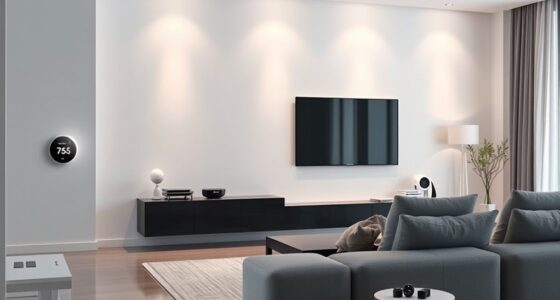To protect your smart home in 2025, start by strengthening your Wi-Fi with WPA3 encryption and strong, unique passwords. Regularly update device firmware and only buy from reputable brands that prioritize security. Use multi-factor authentication and limit data sharing with devices. Monitor activity and data flow, and regularly review your privacy settings. Staying aware of potential risks helps you maintain control. Keep going to learn even more ways to secure your smart home effectively.
Key Takeaways
- Regularly update device firmware and security patches to protect against emerging vulnerabilities.
- Use strong, unique passwords and enable multi-factor authentication for all smart home platforms.
- Implement network segmentation to isolate sensitive devices and reduce potential breach impact.
- Limit data collection by customizing privacy settings and only sharing essential information.
- Choose devices from transparent brands with verified security audits and support for open, encrypted protocols.
Strengthening Your Wi-Fi Network Security
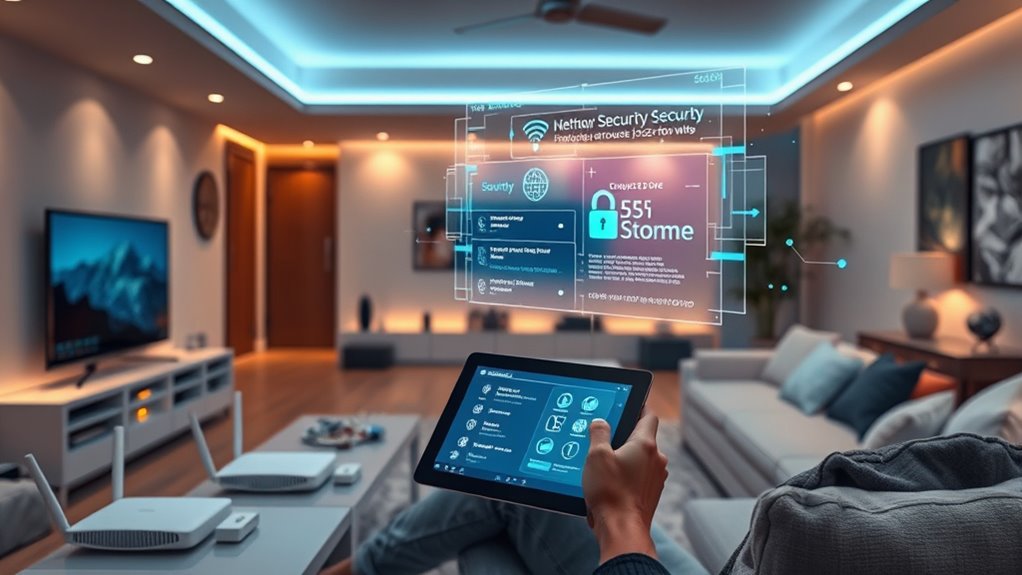
Securing your Wi-Fi network is essential to protect your smart home devices and sensitive data. Start by using WPA3 Personal encryption on your router for strong wireless protection; if unavailable, WPA2 is an acceptable alternative. Avoid outdated protocols like WEP and WPA by updating your router firmware or replacing old equipment. Create a complex, unique password with a mix of letters, numbers, and symbols to prevent unauthorized access. Change the default network SSID to a non-identifiable name to reduce targeted attacks. Never connect to open, unencrypted networks, as they risk data interception. Enable MAC address filtering to restrict access to authorized devices. Set up guest networks limited to internet access and disable SSID broadcasting only if necessary. These steps considerably enhance your Wi-Fi security. Additionally, understanding the importance of contrast ratio in your projector setup can help optimize your home cinema experience. A good device security practice includes regularly reviewing connected devices to identify any unauthorized access. Regularly updating your router firmware also helps close security vulnerabilities and maintain network integrity. Furthermore, being aware of potential vulnerabilities in your network setup allows for more proactive security measures.
Keeping Smart Devices Up-To-Date With Firmware Patches
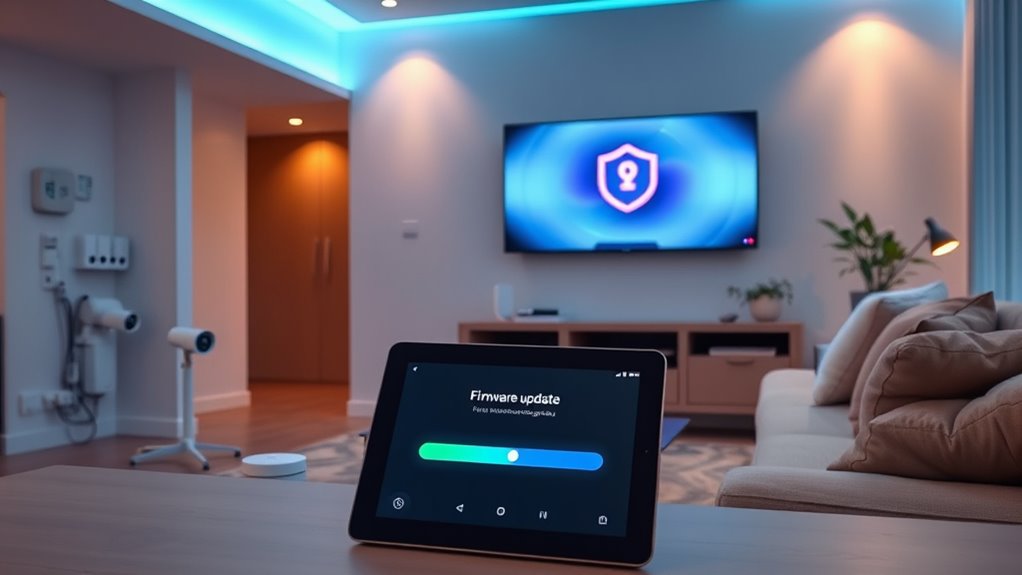
Keeping your smart devices up-to-date with firmware patches is an essential step in maintaining your home’s security. Firmware updates fix security flaws that cybercriminals often exploit, strengthening encryption and authentication to prevent unauthorized access. These updates also improve intrusion detection and secure boot features, making it harder for hackers to compromise your devices. It is important to note that regular maintenance can prevent potential vulnerabilities from being exploited. Skipping updates leaves vulnerabilities open, increasing the risk of data breaches, malware, ransomware, and botnet infections. It also makes your entire smart home network susceptible to attack. To stay protected, enable automatic over-the-air updates, schedule them during low-usage times, and verify their authenticity with cryptographic signatures. Regular updates ensure your devices remain compatible with evolving security standards and help safeguard your privacy and operational stability. Additionally, being aware of signs of spoilage in related products can help you maintain overall safety and hygiene in your connected home environment. Staying informed about building code requirements can also ensure your smart home setup remains compliant with local regulations and standards. Implementing a comprehensive security plan for your smart devices can further reduce potential vulnerabilities and enhance your overall home security. Regularly reviewing device settings and security configurations can help you identify and address emerging threats proactively.
Selecting Reliable Manufacturers With Robust Security Measures
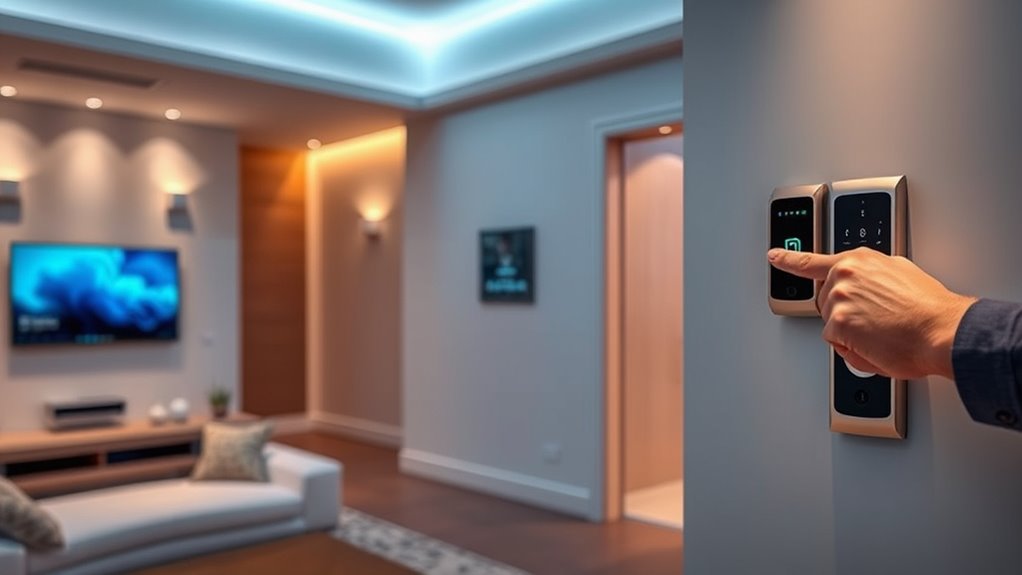
Choosing smart home devices from manufacturers with strong security measures is essential for protecting your privacy. You should prioritize brands with a proven track record of transparency regarding security issues and quick vulnerability disclosures. Look for companies that have undergone third-party security audits and publish results publicly, demonstrating their commitment to security. Support manufacturers active in security standards organizations and industry initiatives, ensuring they stay current with emerging threats. Verify that devices support open, standardized protocols like Matter or Zigbee, and use end-to-end encryption for data. Confirm they implement secure boot, encrypted updates, and mutual device authentication. Additionally, selecting brands that adhere to privacy principles, minimize data collection, and provide clear policies on data use, storage, and user control is crucial. Incorporating security best practices can further enhance your confidence in their security and reliability. Implementing regular updates and security patches ensures vulnerabilities are addressed promptly, maintaining device integrity over time. Paying attention to privacy policies ensures your data remains protected and aligns with your expectations.
Implementing Multi-Factor Authentication for Devices and Accounts
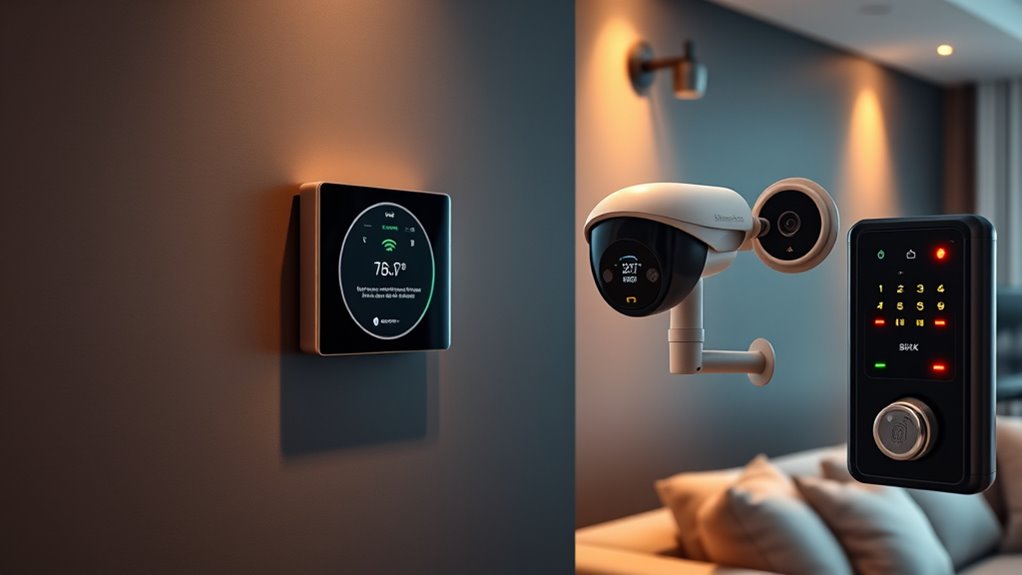
Implementing multi-factor authentication (MFA) is a crucial step in safeguarding your smart home devices and accounts from unauthorized access. MFA adds an extra layer of security by requiring more than just a password, reducing the risk of breaches. With over 35 billion IoT devices worldwide in 2025, strong authentication is necessary to protect interconnected systems from cascading failures. Use methods like authenticator apps generating time-based codes, biometric options such as fingerprint or facial recognition, or security keys like FIDO2 for robust protection. Enable MFA on your smart home platform and device-specific settings, avoid default passwords, and use strong, unique passwords managed through a password manager. Regularly update device firmware and authentication apps to ensure compatibility with the latest security protocols. Cookies and privacy settings also play a role in overall security by controlling data sharing and user access. Incorporating security best practices can further enhance your overall smart home security posture. Additionally, understanding the importance of device security helps in identifying potential vulnerabilities and preventing unauthorized access. Maintaining awareness of vetted security measures such as wave and wind security solutions can contribute to a comprehensive security strategy. Staying informed about latest security developments helps you adapt your defenses to emerging threats.
Enforcing Data Minimization and Privacy Settings
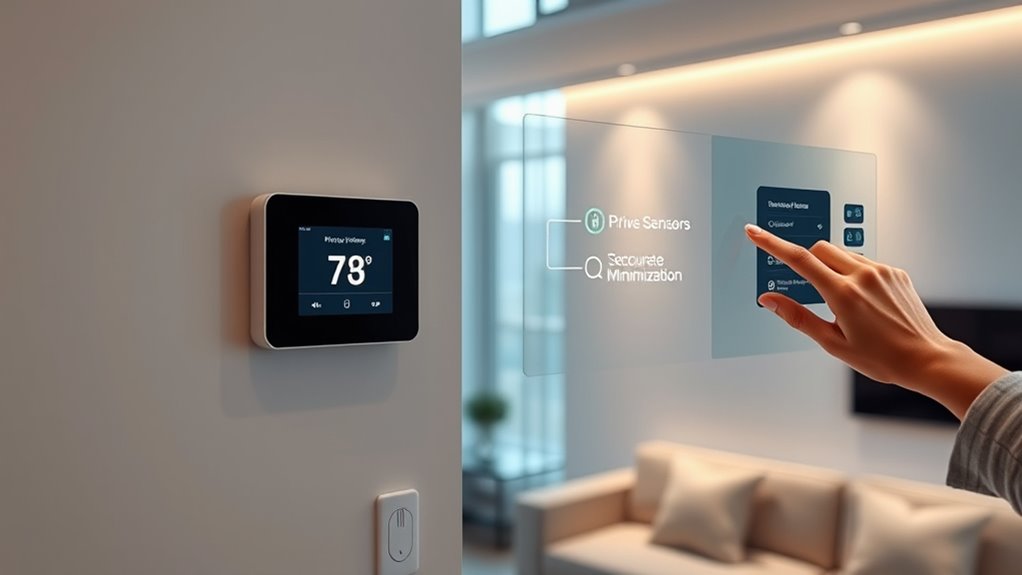
Have you ever considered how much personal information your smart home devices might be sharing? To protect your privacy, start by defining clear reasons for data collection. Only gather data necessary for device functions, and set strict limits on how long it’s stored. Always review and customize privacy settings on each device and app—disable features that don’t contribute to essential performance. Opt out of unnecessary data sharing and revisit your configurations regularly, especially after updates. Use granular controls to restrict access on a per-device or feature basis. Understanding data types helps you make informed decisions about your privacy preferences. Additionally, being aware of data collection practices employed by different devices can guide you in making more secure choices. Staying informed about security vulnerabilities can help you anticipate potential risks and take proactive measures. Being aware of your self-awareness can also help you recognize what information is truly necessary to share. By enforcing data minimization, you reduce exposure risks and maintain greater control over your personal information. Staying proactive ensures your smart home remains a secure and private environment in 2025.
Securing Physical Access to Smart Devices and Infrastructure

Securing physical access to your smart devices and infrastructure is essential to prevent unauthorized entry and tampering. Start by establishing a secure perimeter with fences, gates, and monitored entrances to restrict access. Employ security personnel to verify identities and watch for suspicious activity continuously. Use biometric authentication like fingerprint, facial, or iris scans to strengthen identity verification beyond traditional methods. Screen vehicles entering your property to detect tampering or unauthorized vehicles, especially considering self-driving vehicle vulnerabilities. Implement automated alert systems that monitor access points around the clock, including after hours. Mount critical devices in locked enclosures or on elevated platforms to prevent tampering or theft. Incorporate crochet styles for locs to enhance the security of your infrastructure with creative protective measures. Staying informed about security best practices helps in adapting and strengthening your defenses. Combining these measures ensures a layered, effective defense against physical threats to your smart home infrastructure.
Monitoring Data Transmission and Device Activity Regularly

Regularly monitoring data transmission and device activity is essential for maintaining your smart home’s security. By keeping an eye on network traffic, you can quickly spot unusual data patterns that may indicate malicious activity or hacking attempts. Reviewing device logs helps identify any unauthorized access or suspicious behavior early, so you can respond promptly. Use security tools equipped with AI-driven threat detection to automatically flag anomalies and block threats before they cause harm. Ensuring all devices are running the latest software updates reduces vulnerabilities. Additionally, implementing network segmentation isolates sensitive systems, limiting potential breaches. Consistent oversight of device activity and data flow keeps your smart home safer, giving you peace of mind and control over your privacy.
Educating Users on Smart Home Privacy Risks
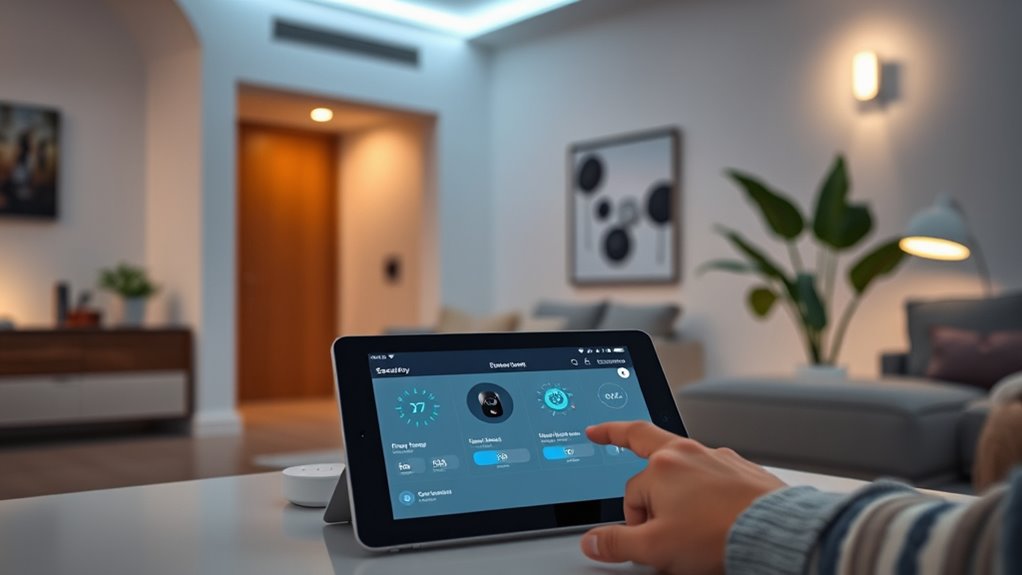
Educating yourself about smart home privacy risks is essential for protecting your personal information and maintaining control over your devices. Unsecured data can be exploited by hackers, leading to unauthorized access and misuse. Weak passwords and unencrypted networks make your devices vulnerable to intrusion. If you don’t properly secure device names and identifiers, you risk revealing household details and location. Sharing data with third parties increases the chance of targeted ads and breaches. Regularly updating devices and using strong, unique passwords help mitigate these risks. Learning about privacy best practices—like managing app permissions, enabling two-factor authentication, and understanding data sharing—empowers you to make informed decisions. Staying informed through news updates and workshops ensures you’re aware of emerging threats and how to protect your smart home effectively.
Ensuring Compliance With Data Privacy Regulations
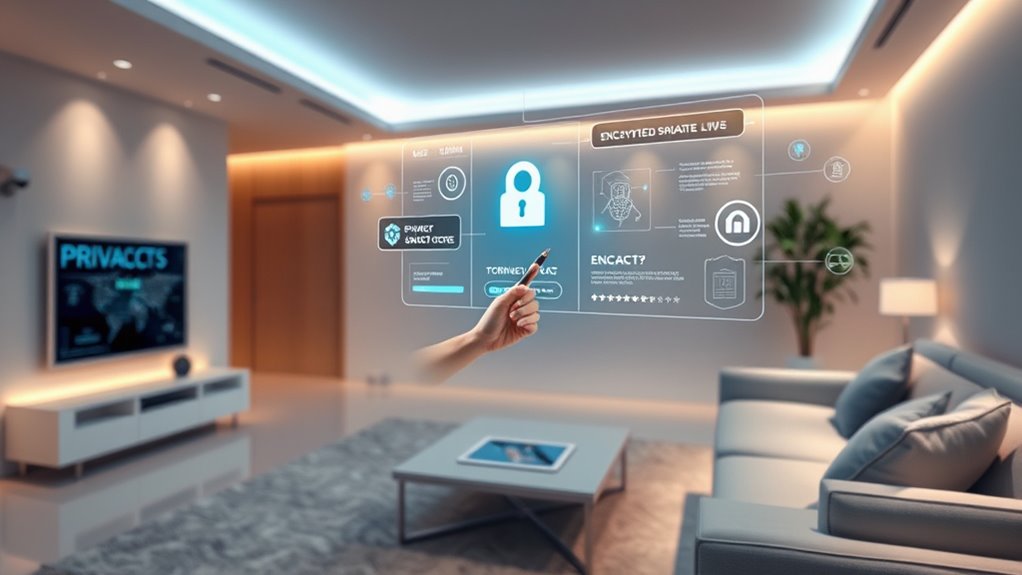
As smart home device users become more aware of privacy risks, understanding how to comply with evolving data privacy regulations becomes increasingly important. In 2025 and 2026, 11 new laws will impact about half of the U.S. population, requiring you to prioritize privacy-by-design principles, transparency, and user rights. You must clearly disclose what data you collect, how it’s used, shared, and stored. Providing easy ways for users to access, correct, delete, or opt out of data collection is essential. Compliance also demands strong security measures to protect user data. Staying updated on state-specific laws, monitoring thresholds, and maintaining records of user consent are *vital* to avoid penalties. Regular privacy assessments and collaborating with legal experts will help you navigate these complex requirements effectively.
Promoting Transparency and Ethical Practices in Smart Home Technology
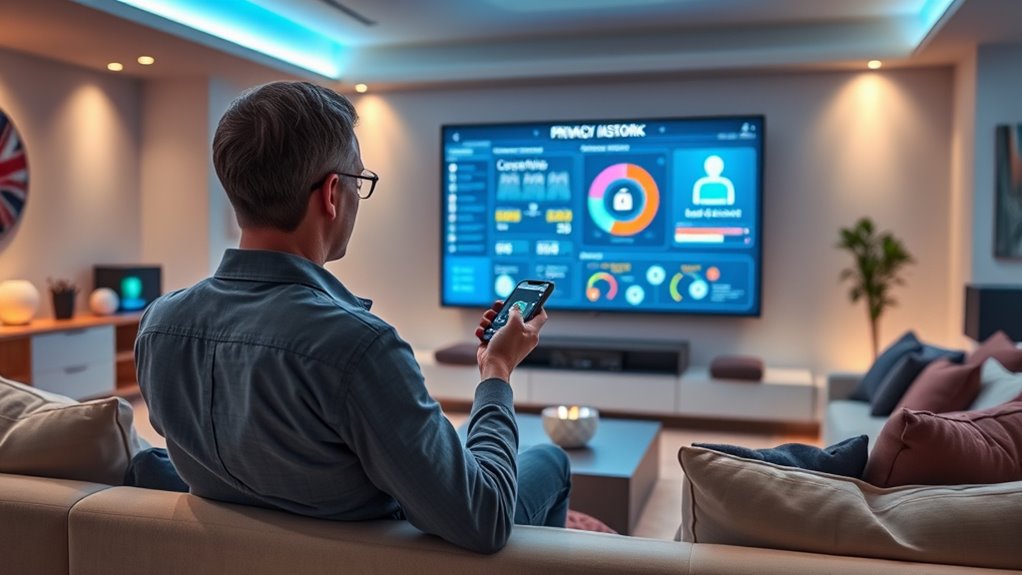
Promoting transparency and ethical practices in smart home technology is essential for building user trust and safeguarding privacy. You should know what types of data your devices collect, like audio, video, or location, and have clear explanations of how that data is processed, stored, and shared. Regular updates to privacy policies ensure you’re informed about changes, fostering trust. Embedding privacy protections from the start—Privacy by Design—minimizes risks, with default settings prioritizing your privacy and requiring your explicit consent for sensitive data. Secure encryption and anonymization protect your identity. You must have control over your data, including access, correction, or deletion options, along with easy opt-out choices. Educating yourself on best practices, along with industry collaboration, helps create a safer, more transparent smart home environment.
Frequently Asked Questions
How Can I Verify if My Smart Home Devices Are Genuinely Secure?
To verify if your smart home devices are secure, you should regularly conduct security audits. Check that all passwords are strong and unique, and confirm devices run the latest firmware. Test network encryption protocols and disable unnecessary services. Enable multi-factor authentication for accounts, and use biometric verification where available. Conduct formal security testing of your devices, monitor activity logs for anomalies, and stay updated on emerging threats to keep your smart home safe.
What Are the Best Practices for Managing Third-Party App Permissions?
You might think managing third-party app permissions is simple, but it’s vital to be thorough. Start by applying the least privilege principle, granting only necessary access. Regularly review and disable unused permissions, and monitor data usage actively. Use access controls and automation tools to keep permissions current. Transparent interfaces and notification systems help you stay informed. Always guarantee apps receive security updates and allow easy data deletion to protect your privacy effectively.
How Do I Detect Unauthorized Access or Unusual Activity in My Smart Home?
To detect unauthorized access or unusual activity in your smart home, you should monitor network traffic continually using anomaly detection systems like machine learning models that analyze data patterns. Set up intrusion detection systems to flag suspicious behaviors, such as unknown device connections or abnormal usage. Enable real-time alerts, strengthen your passwords, and consider biometric authentication like facial recognition to verify users and prevent unauthorized access effectively.
What Steps Should I Take if My Smart Device Is Compromised?
If you realize your smart device is compromised, you should act quickly. First, disconnect it from the internet and your home network to stop further damage. Then, change all related passwords, enable multi-factor authentication if possible, and perform a factory reset. Check for firmware updates, monitor your network for unusual activity, and review device logs. Consider replacing the device if it can’t be secured, and always update your security measures to prevent future breaches.
How Can I Ensure My Smart Home Complies With Evolving Privacy Laws?
Think of your smart home as a garden; if you don’t tend it carefully, weeds (privacy violations) can take over. To stay compliant with evolving laws, you need ongoing vigilance—regularly audit data collection, guarantee transparency, and implement robust security measures. Stay updated on new regulations, train staff, and adapt policies accordingly. By doing so, you protect your digital ecosystem and respect your users’ rights, keeping your smart home safe and lawful.
Conclusion
By following these best practices, you can substantially enhance your smart home’s privacy in 2025. Did you know that 85% of consumers are concerned about smart device security? Staying vigilant with updates, strong passwords, and manufacturer choices isn’t just smart—it’s essential. Taking these steps helps protect your personal data and ensures your smart home remains a secure, private sanctuary amid evolving technology. Your proactive approach makes all the difference.


